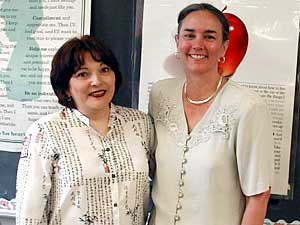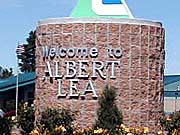|
Audio
Photos
More from MPR
Resources
Respond to this story
|
'A quiet friction' over new immigrants
July 1, 2004
 |
| Genoveva Garza, left, and Teresa Nolander, live in Albert Lea. Garza moved to the area from Mexico four years ago, and is learning English. Nolander has learned Spanish and teaches Spanish classes to community members. (MPR Photo/Jeff Jones) |
Albert Lea, Minn. — Genoveva Garza came to the U.S. about four years ago, seeking a better life for herself and her teenage daughter. In many ways, her struggles to succeed here economically and socially are typical of the new immigrants. But she also shatters some of the stereotypes about immigrants. Garza is in her 40s, a college graduate, and dresses like the professional she is. Garza speaks through an interpreter.
"She was an elementary teacher in Mexico City, and she also worked for the governor's office. When she came up here the work was totally different. She was doing manual labor at that time," explains the interpreter.
 | |||
Genoveva Garza started her life in Albert Lea working on the hog line at the Farmland Foods plants in Minnesota and Iowa. It was one of the few well-paying jobs available where she didn't need to speak English. She earned almost four times as much money cutting up hogs as she did working as a teacher in Mexico.
But there were drawbacks. After three years on the line, the job was taking a toll on her physically. It was a job with no health benefits, and where, she says, she got no respect from employers. Eventually, she quit.
"They were treated as animals in the plants. No rights, no benefits," Garza says through her interpreter.
Ideally, Garza would like to work in an elementary school teaching Spanish, but obviously she wants to finish learning English first.
Garza says everything about her life has changed since coming to America. She says she's made adjustments "little by little." But she hasn't had to do it completely alone. After she left the meatpacking job, a local church made an apartment available to Garza and her daughter. Friends have helped her find work cleaning houses.
Our interpreter for this story, long-time Albert Lea resident Teresa Nolander, guided Garza through the process of getting a federal grant. It pays her tuition at the community college, where she's learning English.
 | |||
"I met Genoveva and she spoke no English, and didn't know anybody," says Nolander. "I spoke almost no Spanish, but together we managed to communicate, and I've learned a lot in the last few years."
One of the things Teressa Nolander learned is fluent Spanish. Very few non-Hispanics have that ability in Albert Lea, and Nolander has turned her skill into a job. She works in a program run through the local community college called "Command Spanish." It's geared to teach hospital workers and others in the health field rudimentary communication skills in Spanish.
Nolander says others in the business community are starting to take advantage of the program, too. She's thrilled about that, and the efforts of the public school system to teach all immigrants English. It will bring the community together, she says.
Not everyone is thrilled, though. Paul Westrum says all the money being spent on English as a second language for immigrants could better be spent on improving education for the people who grew up here.
Westrum is one of the few in town who openly opposes the influx of immigrants. Others say he's not alone. He has formed a multi-state organization in the Midwest, the Federation for American Immigration Reform, to reduce immigration. He sees the increasing numbers as a threat, financially and culturally.
|
The majority of us Hispanics believe the majority of Americans reject us, but it really isn't that way. When the people see that you have come to America to work, you are honest and hard-working and want to get ahead, they welcome you with open arms.
- Genoveva Garza |
For one thing, he says, immigrants live in ways here that help them avoid paying taxes.
"When they come to the community, sometimes two or three people rent out the house. And next thing, 20 to 25 people are living there so the taxes are not really being paid," Westrum says. "When these people come, they end up sending approximately 30 percent of their wages back to their home country. And they'll come to our food pantries, Salvation Army, and ask for things to replace the money they sent home."
Paul Westrum claims immigrants get too much government assistance, and undocumented workers falsify records to get benefits. What's more, Westrum says, they are taking jobs that otherwise would go to American citizens.
None of those claims sits well with Linda Cruz Lares, also of Albert Lea.
"When I hear, 'Oh, they are taking our jobs,' Well, I'm sorry -- there are jobs no one will do, no one wants to take, and we need them to be filled," says Lares.
Linda Lares directs an agency that helps new immigrants throughout Freeborn County adjust to life in Minnesota. She has little patience for those who claim immigrants are somehow pampered, or not contributing their fair share to the Minnesota economy.
"I've heard that remark lots. 'They just come and are on welfare and public assistance, and are just draining our community,'" she says. "Let me set the record straight. If we have newer immigrants in our community, they are not eligible for public assistance -- and so again, another myth."
Linda Cruz Lares has lived in Albert Lea all her life. Her grandfather was a farmer here back in the 1930s, and she takes great pride in her hometown. She hesitates to even use the word "problems" in discussing immigrants.
"This is a welcoming place. Who wouldn't want to live here?" she says. "It's beautiful, clean, friendly."
She acknowledges, though, that there is a quiet friction over the new groups of immigrants.
"Yes, small town USA, Albert Lea. It isn't any different than anyplace else. We have people who stereotype, racism, discrimination, just like every place else," says Lares. "There are lots of good people, and a few who aren't so nice. However, over the years I can also attest that our community has come together and said,'We need new people. How can we be proactive, be educational?'"
Genoveva Garza, the immigrant teacher from Mexico, has another year of studying English. Then she hopes to get a teaching job in a parochial school. She says some immigrants in Minnesota get discouraged because learning English is so hard. Making it in America, fitting in here, is harder than they expected.
Some feel isolated, she says, and long to go back home. But Garza plans to stay. There are misunderstandings with non-Hispanics, but she says that's a two-way street. She encourages other immigrants to be patient.
"The majority of us Hispanics believe the majority of Americans reject us, but it really isn't that way. If we don't know how to speak English, how can they communicate with us? When the people see that you have come to America to work, you are honest and hard-working and want to get ahead, they welcome you with open arms," says Garza.
|
News Headlines
|
Related Subjects
|

